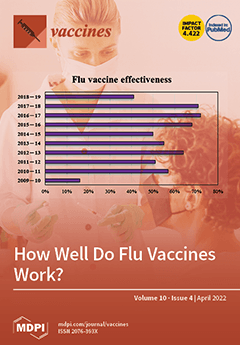Open AccessArticle
COVID-19 Vaccine Hesitancy and Determinants of Acceptance among Healthcare Workers, Academics and Tertiary Students in Nigeria
by
Emmanuel O. Njoga, Philip P. Mshelbwala, Kenneth O. Abah, Olajoju J. Awoyomi, Kinley Wangdi, Shedrach B. Pewan, Felix A. Oyeleye, Haruna B. Galadima, Salisu A. Alhassan, Chinwe E. Okoli, Elisha Z. Kwaja, Onyinye S. Onwumere-Idolor, Everest O. Atadiose, Priscilla O. Awoyomi, Musawa A. Ibrahim, Kabiru M. Lawan, Shehu A. Zailani, Mohammed D. Salihu and Charles E. Rupprecht
Cited by 23 | Viewed by 4078
Abstract
The COVID-19 pandemic has resulted in millions of human deaths, prompting the rapid development and regulatory approval of several vaccines. Although Nigeria implemented a COVID-19 vaccination program on 15 March 2021, low vaccine acceptance remains a major challenge. To provide insight on factors
[...] Read more.
The COVID-19 pandemic has resulted in millions of human deaths, prompting the rapid development and regulatory approval of several vaccines. Although Nigeria implemented a COVID-19 vaccination program on 15 March 2021, low vaccine acceptance remains a major challenge. To provide insight on factors associated with COVID-19 vaccine hesitancy (VH), we conducted a national survey among healthcare workers, academics, and tertiary students, between 1 September 2021 and 31 December 2021. We fitted a logistic regression model to the data and examined factors associated with VH to support targeted health awareness campaigns to address public concerns and improve vaccination rates on par with global efforts. A total of 1525 respondents took part in the survey, composed of healthcare-workers (24.5%, 373/1525), academics (26.9%, 410/1525), and students (48.7%, 742/1525). Only 29% (446/1525) of the respondents were vaccinated at the time of this study. Of the 446 vaccinated respondents, 35.7% (159/446), 61.4% (274/446) and 2.9% (13/446) had one, two and three or more doses, respectively. Reasons for VH included: difficulty in the vaccination request/registration protocols (21.3%, 633/1079); bad feelings towards the vaccines due to negative social media reports/rumours (21.3%, 633/1079); personal ideology/religious beliefs against vaccination (16.7%, 495/1079); and poor confidence that preventive measures were enough to protect against COVID-19 (11%, 323/1079). Some health concerns that deterred unvaccinated respondents were: innate immunity issues (27.7%, 345/1079); allergic reaction concerns (24.6%, 307/1079); and blood clot problems in women (21.4%, 266/1079). In the multivariable model, location of respondents/geopolitical zones, level of education, testing for COVID-19, occupation/job description and religion were significantly associated with VH. Findings from this study underscore the need for targeted awareness creation to increase COVID-19 vaccination coverage in Nigeria and elsewhere. Besides professionals, similar studies are recommended in the general population to develop appropriate public health interventions to improve COVID-19 vaccine uptake.
Full article
►▼
Show Figures






